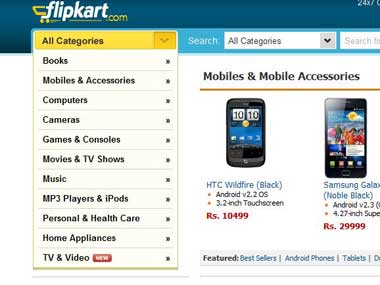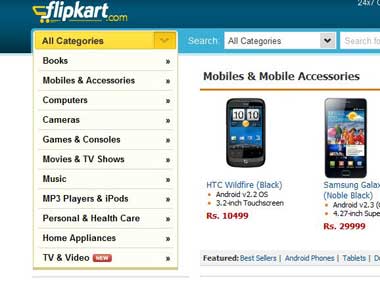New Delhi: Foreign direct investment in e-commerce will boost infrastructure development and spur manufacturing facility among other advantages, but it could also lead to large scale job losses, says a discussion paper by DIPP.
Listing out eight advantages of permitting foreign direct investment (FDI) in business-to-consumer segment, the Department of Industrial Policy and Promotion’s (DIPP) paper said that it would also improve customer service.
[caption id=“attachment_222952” align=“alignleft” width=“380”]  Screengrab from Flipkart website[/caption]
It would provide “more responsive order taking and after-sales service to customers and competitive pricing; increased access to buyers/sellers, allow MSMEs and artisans to reach out to customers far beyond their immediate location, both locally within India and abroad”, the paper said.
It also said the move will lead to better work culture and customer service besides reducing the need for middlemen leading to lower transaction costs, reduced overhead and reduced inventory and labour costs.
However, the paper said the development works against the spirit of FDI policy in multi-brand retail trading (MBRT). The government has last year permitted 51 percent FDI in MBRT.
“Allowing FDI in e-commerce will provide e-commerce players complete geographical reach which will be against the spirit of FDI in MBRT i.e being restricted to cities with a population of more than one million or any other city as per the choice of consenting states,” the paper said.
It also said that Indian market is not yet ready for opening up e-retail space to foreign investors.
“It will seriously impair small time trading of brick and mortar stores. Small time shopkeepers are not highly qualified and will not be able to compete with sound e-retail business format.
Impact Shorts
More Shorts“Because of scale of economic operations, e-commerce players in the inventory based model will have more bargaining power than standalone traders and will resort to predatory pricing,” it said.
Small time kirana stores remain the largest source of employment in the country. Opening of B2C e-commerce on inventory based model is likely to seriously impact these shopkeepers leading to large scale unemployment, it added.
India’s FDI policy restricts e-commerce companies from offering services directly to retail consumers. At present, 100 percent FDI is allowed in business-to-business (B2B) e-commerce but not in retail trading.
The paper said the infrastructure created by major players will be captive and government will not be able to to achieve its objective of creating back end infrastructure.
“Indian e-commerce market is at nascent stage of development. With FDI in e-commerce, global players will have adverse impact on this domestic industry. It will lead to monopolies in e-commerce, manufacturing, logistics and retail sector,” it added.
The DIPP has sought public comments on the paper till January 30.
The discussion paper said opening of B2C e-commerce may led to dumping of cheaper products by multi-national firms in the market causing a negative impact on the Indian manufacturing sector in general and to MSMEs in particular.
It also said allowing the entry of inventory based large foreign e-tailers may shrink Indian entrepreneurship and the MSME sector.
In its conclusion and recommendations, it said overall, e-commerce including online retail in India constitutes a small fraction of total sales, but is set to grow to a substantial amount owing to a lot of factors such as rising disposable incomes and rapid urbanisation.
The discussion paper is put out to seek the views of relevant stakeholders on the issues like should FDI be allowed in B2C e-commerce, should it be open for all products or only non-food products and should a limit for percentage of sourcing from domestic manufacturers be prescribed? The paper also asks suggestions over the FDI limit.
“How will retail sale under MBRT be restricted to States that have agreed to open frontend stores? What should the entry routes and caps be in FDI in B2C e-commerce companies? Should it be automatic up to 50 percent?” it asked.
The DIPP’s paper also sought views from stakeholders on what are likely benefits to Indian economy particularly in terms of - FDI inflows (amount); additional employment; back-end infrastructure; efficiency and What should B2C e-commerce encompass - goods, services, intellectual property.
By 2013, the market is expected to reach USD 12.6 billion, showing year to year growth of 34 percent.
According to a report, global business-to-consumer e-commerce sales will pass the USD 1,250 billion mark by 2013, and the total number of internet users will increase to about 3.5 billion.
On the current status of e-commerce sector in India, it said that growth of the industry has been phenomenally high.
However, its growth is dependent on a number of factors and most important of them is internet connectivity.
As per Forrester McKinsey report of 2013, India has 137 million internet users with penetration of 11 percent. Total percentage of online buyers to internet users is 18 percent.
Compared to India, China, Brazil, Sri Lanka and Pakistan have internet population of 538 (40 percent), 79 (40 percent), 3.2 (15 percent) and 29 (15 percent) millions respectively, it said adding, “therefore, lower internet density continues to remain a challenge for e-commerce”.
The paper informed that currently, the inventory based consumer e-commerce model alone provides direct employment to about 40,000 people and is estimated to create 1 million direct and another 0.5 million indirect jobs by 2020.
“Indian e-commerce industry is in nascent stage and is nowhere in the league of big global players. Major domestic e-commerce companies are Flipkart, Snapdeal, Fashionandyou, Myntrainkfruit, Dealsandyou, Homeshop18 etc,” it added.
The paper said that although many factors support the growth of e-commerce in India, the fledgling industry is faced with significant hurdles with respect to infrastructure, governance and regulation.
Over 70 percent of all consumer transactions in India are travel related, comprising mainly of online booking of airline tickets, railway tickets and hotel bookings.
“The biggest players in the travel category are Makemytrip.com, Yatra.com and the IRCTC website for railway bookings. Non-travel related online commerce comprises 25-30 percent of the B2C e-Commerce market,” it said.
It also said the growing e-commerce industry can have a positive spillover effect on associated industries such as logistics, online advertising, media and IT/ITES. Currentlye-commerce accounts for 15-20 percent of the total revenues for some of the big logistics companies.
It said around 90 percent of the global e-commerce transactions are stated to be in the nature of B2B, leaving meagre 10 percent as B2C e-commerce.
“Moreover Indian e-commerce industry is characterised by Market Place model. It allows large number of traders especially MSMEs to advertise their products on the Market Place and benefit from increased turnover,” it added.
The paper further said representations have also been received from certain multinational companies on the matter. It said one such MNC has stated that open and deregulated e-commerce sector would create new markets for small businesses and generate employment in supply chain management.
Further, the paper said the views of domestic e-commerce companies are divided. “This is on account of varying commercial considerations of entrepreneurs i.e. opting to stay in or exiting out of business, capital requirement, choosing between financial and strategic investment, etc,” it added.
It informed that a national body of traders has strongly opposed allowing any FDI in e-commerce.
“They have stated that Indian market is not yet ready for opening up e-retail space to foreign investors. FDI in the sector will have disastrous impact on domestic industry…causing large scale unemployment,” the paper said.
It said that the legal requirements for undertaking e-commerce in India also involve compliance with other laws like Contract Law and Indian Penal Code. Online shopping in India also involves compliance with the banking and financial norms applicable in India.
Citing a report E-Commerce Index of 2012, it said China occupies first place and the G8 countries (Japan, United States, United Kingdom, Germany, France, Canada, Russia, andItaly) fall within the top 15.
“India is not ranked. India, the world’s second most populous country, does not make the Top 30, because of low Internet penetration and poor financial and logistical infrastructure compared to other countries,” it said.
PTI


)

)
)
)
)
)
)
)
)



